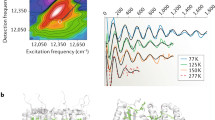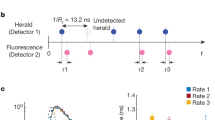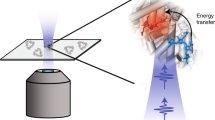Abstract
THE fluorescence intensity of a photosynthetic organism at any instant is a measure of the concentration of excited chlorophyll and it has, therefore, been one of the most studied of all the phenomena related to photosynthesis. Fluorescence lifetimes are a direct measure of the rate of energy transfer from the light collecting unit to the chemical trap. Lifetimes in the nanosecond region have been measured by many workers, following the pioneering work of Brody and Rabinowitch1, but these have been near the limit of time resolution of the apparatus used. Much shorter average lifetimes have been measured by phase shift methods2. The picosecond pulses which are available from mode-locked lasers have now made possible a fully time-resolved study of fluorescence decay in the photosynthetic units of algal chloroplasts and their fragments.
This is a preview of subscription content, access via your institution
Access options
Subscribe to this journal
Receive 51 print issues and online access
$199.00 per year
only $3.90 per issue
Buy this article
- Purchase on Springer Link
- Instant access to full article PDF
Prices may be subject to local taxes which are calculated during checkout
Similar content being viewed by others
References
Brody, S. S., and Rabinowitch, E., Science, 125, 555–558 (1957).
Borisov, A. Yu., and Il'ina, M. D., Biochim. biophys. Acta, 305, 364–371 (1973).
Duguay, M. A., and Hansen, J. W., Appl. Phys. Lett., 15, 192–194 (1969).
Seibert, M., and Alfano, R. R., Biophys. J., 14, 269–283 (1974).
Porter, G., Reid, E. S., and Tredwell, C. J., Chem. Phys. Lett., 29, 469–472 (1974).
Bradley, D. J., Liddy, B., and Sleat, W. E., Optics Commun., 2, 391–395 (1971).
Kollman, V. H., Shapiro, S. L., and Campillo, A. J., Biochem. biophys. Res. Commun., 63, 917–923 (1975).
Shieh, Y. J., and Barber, J., Biochim. biophys. Acta, 233, 594–603 (1971).
Barber, J., Telfer, A., and Nicolson, J., Biochim. biophys. Acta, 357, 161–165 (1974).
Anderson, J. M., and Boardman, N. K., Biochim. biophys. Acta, 112, 403–421 (1966).
Arnon, D. I., Pl. Physiol., Lancaster, 24, 1–15 (1949).
Briantais, J. M., Merkelo, H., and Govindjee, Photosynthetica, 6, 133–141 (1972).
Beddard, G. S., Porter, G., and Weese, G. M., Proc. R. Soc., A 342, 317–325 (1975).
Emerson, R., and Lewis, C. M., Am. J. Bot., 30, 165–178 (1943).
Williams, W. P., Murty, N. R., and Rabinowitch, E., Photochem. Photobiol., 9, 455–469 (1969).
Noyes, R. M., in Progress in Reaction Kinetics, 1 (edit. by Porter, G.), 129–160 (Pergamon, Oxford, 1961).
Author information
Authors and Affiliations
Rights and permissions
About this article
Cite this article
BEDDARD, G., PORTER, G., TREDWELL, C. et al. Fluorescence lifetimes in the photosynthetic unit. Nature 258, 166–168 (1975). https://doi.org/10.1038/258166a0
Received:
Accepted:
Issue Date:
DOI: https://doi.org/10.1038/258166a0
This article is cited by
-
Artificial photosynthetic cells with biotic–abiotic hybrid energy modules for customized CO2 conversion
Nature Communications (2023)
-
Remembering James Barber (1940–2020)
Photosynthesis Research (2022)
-
Triplet state involvement in primary photochemistry of photosynthetic photosystem II
Nature (1976)
-
Concentration quenching in chlorophyll
Nature (1976)
Comments
By submitting a comment you agree to abide by our Terms and Community Guidelines. If you find something abusive or that does not comply with our terms or guidelines please flag it as inappropriate.



